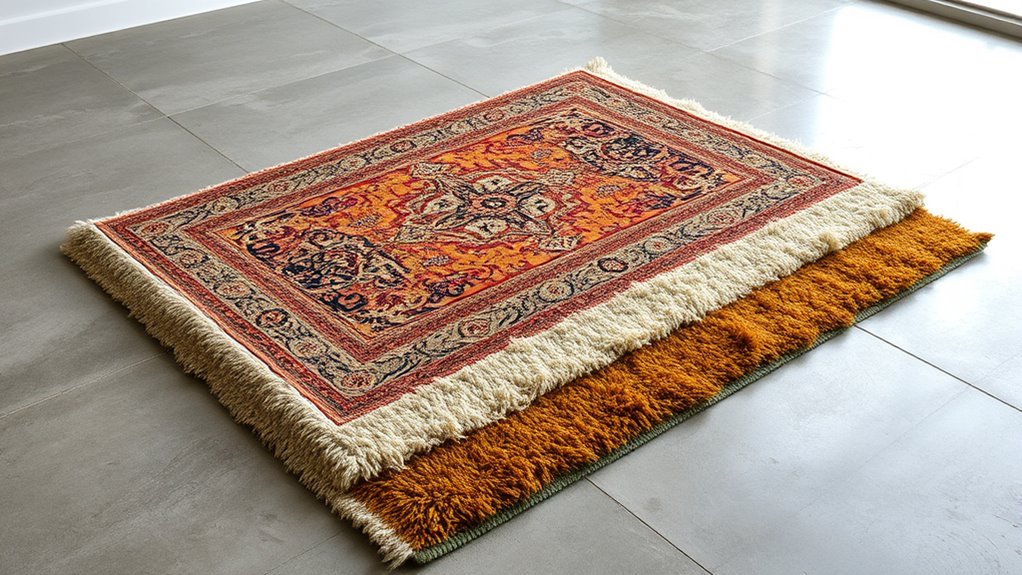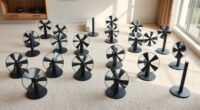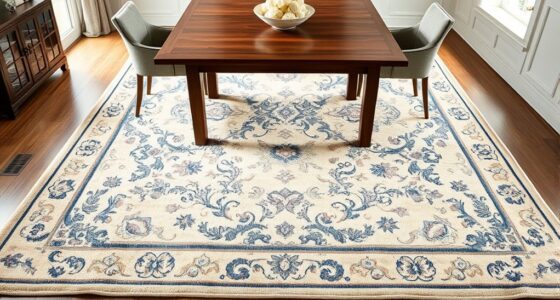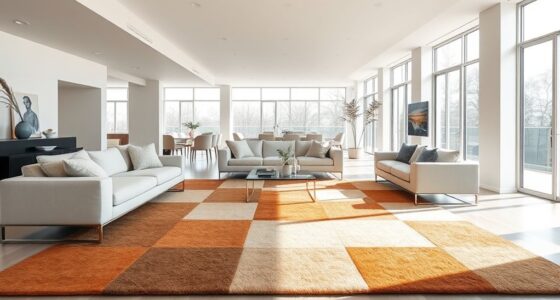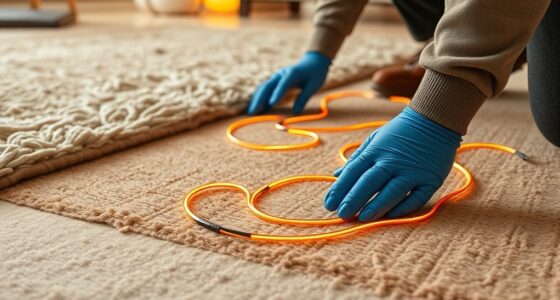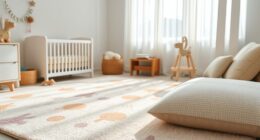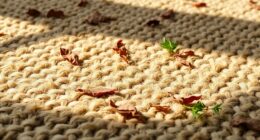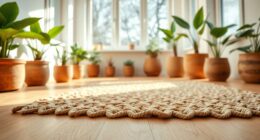To style multiple rugs on polished concrete, start with a neutral, textured base rug that fits your space. Layer contrasting patterns, textures, and pile heights to add depth and visual interest. Use different sizes and styles to define zones or evoke seasonal moods, coordinating colors for harmony or striking contrast. Regular maintenance keeps your layered look fresh and inviting. Keep exploring to discover expert tips on creating stunning, multi-layered rug arrangements that transform your space.
Key Takeaways
- Choose rugs with non-slip backing to prevent slipping on polished concrete floors.
- Vary textures, patterns, and pile heights to add visual depth and interest.
- Use neutral or complementary colors to create cohesive layered arrangements.
- Define different zones by layering rugs of varying sizes and styles for functional spaces.
- Regularly clean and rotate rugs to maintain their appearance and durability over time.
Choosing the Perfect Base Rug for Your Space

Selecting the right base rug is essential because it sets the foundation for your entire layered look. You want a rug that complements your space’s size and style while providing durability. Start by measuring your area to choose a rug that fits comfortably without overwhelming the room. For a polished concrete floor, opt for a rug with a non-slip backing to prevent slipping and damage. Neutral colors like beige, gray, or taupe work well as a versatile base, allowing you to add layered textures and patterns without clashing. Consider materials like wool or synthetic fibers for durability and ease of maintenance. Your base rug should anchor the space, making it inviting and cohesive, so choose one that aligns with your overall aesthetic and practical needs. Choosing the right rug material is also important to ensure longevity and comfort.
Layering Techniques for Visual Interest
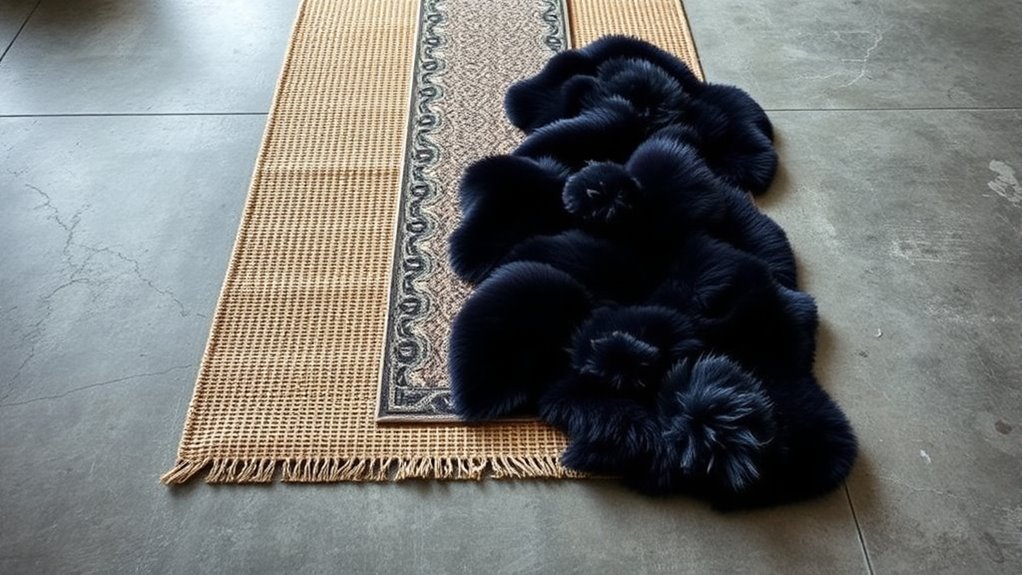
To create a dynamic and inviting layered rug display, focus on varying textures, patterns, and heights to add visual interest. Mix flat weaves with plush or shaggy layers to create depth. Use contrasting patterns, like geometric and floral, to keep the eye moving. Play with different pile heights to add dimension and avoid a flat look. To help visualize, consider this table:
| Layering Tip | Effect |
|---|---|
| Combine smooth and textured rugs | Adds tactile variety |
| Mix bold and subtle patterns | Creates visual contrast |
| Use different pile heights | Adds depth and shadow |
| Layer small and large rugs | Balances scale |
| Vary colors within the palette | Enhances interest without clashing |
These techniques will make your polished concrete space feel layered and lively. Incorporating color contrast can further elevate the visual appeal by emphasizing the layered effects.
Mixing Textures and Patterns to Enhance Depth

Mixing textures and patterns is a powerful way to add depth and visual interest to your layered rug display. By combining different materials, like plush wool with coarse jute or sleek synthetics, you create tactile contrast that draws the eye. Incorporate patterns such as geometric shapes, stripes, or floral motifs to break monotony and introduce focal points. Varying sizes and styles of rugs prevent the setup from feeling flat, making your space more dynamic. To keep it cohesive, balance bold patterns with neutral textures, ensuring no element overwhelms the others. You want each layer to complement, not compete with, the rest. Understanding divorce statistics can remind us of the importance of careful planning and support when navigating significant transitions, just as thoughtfully combining diverse textures and patterns enhances the layered rug display. When you thoughtfully combine diverse textures and patterns, your layered rug display gains a rich, multidimensional quality that enhances the overall aesthetic.
Color Coordination and Contrast Strategies

When layering rugs, you need to think about harmonizing tones and creating striking contrasts. Balancing light and dark colors helps your space feel both cohesive and dynamic. By choosing the right combinations, you can make your layered rug display truly stand out. Incorporating color coordination strategies inspired by successful design principles can enhance the visual appeal of your space.
Harmonizing Rug Tones
Harmonizing rug tones involves carefully selecting colors that either complement or create appealing contrasts within your space. You want your layered rugs to enhance the overall aesthetic without clashing or overpowering. To achieve this, consider color relationships like analogous, complementary, or neutral tones. These choices help create a cohesive look or striking visual interest. Use the table below to understand how different tone strategies work: Additionally, understanding water-related concepts can inspire fresh design ideas that evoke tranquility and natural harmony in your decor.
Balancing Light and Dark
Balancing light and dark tones in your rug layering creates visual harmony and depth in your space. To achieve this, mix rugs with contrasting shades—pair a light, neutral base with darker accents or vice versa. This contrast draws the eye and adds dimension without overwhelming the room. Consider the overall color palette; if your room has warm hues, incorporate warm-toned dark rugs to maintain cohesion. Conversely, if your space is cooler, opt for dark rugs with hints of light to create balance. Layering rugs with varying lightness and darkness helps prevent monotony and highlights different textures. Remember, the goal is to create a dynamic yet cohesive look, so experiment with different contrasts until you find a balanced combination that enhances your polished concrete floor. Proper maintenance and cleaning also play a vital role in preserving your rugs’ appearance and longevity, ensuring your layered rug design remains attractive over time.
Arranging Multiple Rugs for Defined Zones

To create clear zones with multiple rugs, you should consider zone differentiation strategies like size, pattern, and placement. These choices help define distinct areas without cluttering the space. Additionally, using visual cohesion tips, such as coordinating colors or styles, guarantees your zones feel connected and balanced. Incorporating a consistent theme across your rugs can further enhance the harmony and flow between different zones.
Zone Differentiation Strategies
Arranging multiple rugs to define different zones in a room helps create a clear sense of purpose and organization. To do this effectively, consider the function of each area—living, dining, or workspace—and select rugs that complement these functions. Use size and placement to delineate boundaries clearly; larger rugs can anchor a seating area, while smaller ones mark specific spots like a reading nook. Layer rugs with contrasting textures or patterns to emphasize distinct zones without cluttering the space. Keep a consistent color palette to maintain harmony across zones. Position rugs to guide movement naturally and avoid overlapping too much, which can blur boundaries. Incorporating open floor plans can further enhance the fluidity and versatility of your space. Thoughtful zone differentiation enhances both the aesthetics and functionality of your polished concrete space.
Visual Cohesion Tips
Creating visual cohesion when layering multiple rugs requires careful attention to how their colors, patterns, and textures work together. To achieve a unified look, consider these tips:
- Choose a consistent color palette that complements your space. Stick to shades within the same family or pick contrasting hues that create harmony.
- Mix patterns thoughtfully—pair geometric designs with subtle textures to avoid visual clutter, ensuring they don’t compete.
- Vary textures strategically to add depth without overwhelming the space. Combine plush, woven, or flat rugs, but keep their overall tone cohesive.
Seasonal and Themed Rug Combinations

Seasonal and themed rug combinations allow you to refresh your space and reflect the changing atmosphere throughout the year. To do this effectively, consider switching out rugs or layering pieces that match each season’s mood. For spring, opt for lighter colors, floral patterns, or pastel shades layered with neutral tones. In summer, incorporate vibrant, bold patterns or natural textures like jute or sisal. Autumn calls for warmer hues, such as burnt orange or deep reds, combined with cozy textures. During winter, layer plush, textured rugs in dark or festive colors. The key is to select rugs that evoke the season’s vibe while maintaining visual harmony with your polished concrete. Incorporating rug layering techniques can add depth and interest to your decor, making your space feel more curated and dynamic. This approach keeps your space dynamic and inviting, without overwhelming the aesthetic.
Maintenance Tips for Multi-Layered Rug Displays
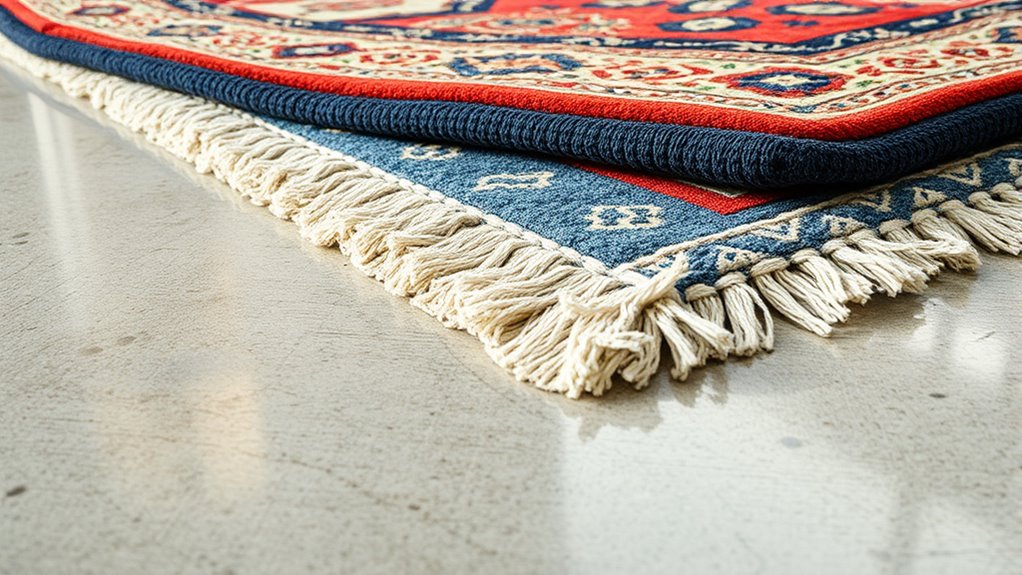
Maintaining the appearance and longevity of your multi-layered rug display requires regular care and attention. Proper upkeep ensures your layered look stays vibrant and inviting.
Here are three essential tips:
- Vacuum regularly – Use a gentle setting to remove dirt and debris without damaging delicate fibers or causing fraying.
- Rotate layers periodically – This prevents uneven wear and helps maintain the rug’s shape and color.
- Address spills immediately – Blot spills with a clean, damp cloth to prevent stains from setting, and avoid harsh chemicals that can damage your rugs.
- Be mindful of heat sources – Keep rugs away from direct heat or excessive sunlight, which can cause fading and deterioration over time.
Consistent cleaning and mindful handling keep your multi-layered rug display looking fresh and stylish for years to come.
Frequently Asked Questions
How Do I Prevent Rugs From Slipping on Polished Concrete?
You want to prevent rugs from slipping on polished concrete, so start by choosing a rug with a non-slip backing or add a rug pad underneath. Make sure the pad is specifically designed for smooth surfaces, as it provides extra grip. Regularly check the rug’s position and replace worn-out pads. These simple steps help keep your rug secure and safe, preventing slips and falls.
What Are the Best Rug Materials for High-Traffic Areas?
Did you know that nylon rugs are 40% more durable in high-traffic areas? When choosing the best rug materials, opt for nylon, polypropylene, or wool, as they withstand wear and tear better. You should also consider rugs with non-slip backing or add grip pads underneath. These choices help prevent slipping and make sure your rug stays in place, even in busy spaces.
Can Layered Rugs Be Used Outdoors on Concrete Patios?
You can definitely use layered rugs outdoors on concrete patios, but choose weather-resistant materials like polypropylene or acrylic to guarantee durability. Opt for rugs with sturdy, non-slip backing to prevent slipping on the concrete. Layering adds style and comfort, but always consider the climate—bring rugs inside during heavy rain or harsh weather. Properly selected and maintained, layered outdoor rugs can beautifully enhance your patio space.
How Do I Clean Layered Rugs Without Damaging the Layers?
Think of cleaning layered rugs like tending to a delicate garden. You gently remove dirt and stains without disturbing the layers beneath. Use a soft brush or vacuum on a gentle setting, and spot clean with mild detergent and water. Avoid harsh scrubbing or soaking, as this can damage the layers. Treat your rug like a prized flower, caring for it softly to keep its beauty intact.
What Safety Considerations Exist With Multi-Rug Stacking Indoors?
When stacking multiple rugs indoors, you should consider safety to prevent slips, trips, and falls. Make sure the rugs have non-slip backing or add rug pads to keep them secure. Avoid stacking rugs on uneven surfaces or in high-traffic areas. Regularly check that the layers stay in place, especially if kids or pets are around. Properly secured rugs help create a safe, stylish space without risking accidents.
Conclusion
Layering rugs on polished concrete is like painting with fabric—each piece adding depth and personality. By choosing the right bases, mixing textures, and arranging thoughtfully, you create a dynamic space that feels both cozy and curated. Keep seasonal updates fresh and maintain your layers to keep your design shining. Think of your layered rugs as a living canvas—always ready to tell a new story with every change and step you take.
